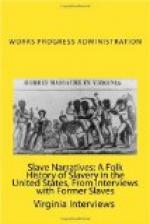“Right after the War, my folks farmed for a living. They farmed on shares. They didn’t have nothing of their own. They never did get nothing out of their work. I know they didn’t get a thing. They farmed at first about seven miles out from Little Rock, below Fourche Dam on the Fletcher place. There ain’t but one of the Fletchers living now, and that is Molly Daniels. She is old Louis Fletcher’s daughter. All their brothers is dead. She’s owning all the land now we used to till. It’s over a thousand acres. She [HW: mother] stayed down there for about twenty or thirty years. Then she moved here to town. Here she cooked for white folks. My mother died about forty years ago—forty-two or three years; she’s been dead sometime. My wife has been dead now for twelve years.
“I didn’t get but a little schooling, for my father used to send me after the mules. One day the wheelbarrow had a load of bricks on it. It was upset. They had histed the bricks up on a high platform. It turned over as I was passing underneath, and one fell on me and struck my head. It was a long time after that before they would let me go to school again. After that I never got used to studying any more.
“My first teacher was Lottie Andrews (Charlotte Stephens). I had some more teachers too. Lemme see—Professor Fish was a white man. We had colored teachers under him. Then we had R.B. White. He was Reuben White’s brother. R.B. White’s wife was a teacher. Professor Fish was the superintendent. There ain’t no truth to the tale that Reuben White was put in a coffin before he was dead. Reuben White built the First Baptist Church here and Milton White built a big church in Helena. They were brothers. Them was two sharp darkies.
“When I first started working, I drove teams. I raised crops a while and farmed. Then I left the country and come to town and got up to be a quarry man for years. Then I quit that and went to driving teams for the Merchant Transfer Company for years. Then I quit that and run on the road—the Mountain—for four years. Then I taken a coal chute on the Rock Island and run it for four years. Then I quit and went to working as an all-’round man in the shop. I stayed with them about nine years. Then I taken down in the shape that I am now.
“I have been out here to this hospital for twenty-four years going on twenty-five. Been down so that I couldn’t hit a lick of work for twenty-five years. I have been in this building for eleven years. I get along tolerable fair. As the old man says, we can just live.
“I think the young people are going wild and if something isn’t done to head them off pretty soon, they’ll go too far. They ain’t looking at what’s going on up the road; they just call theirselves having a good time. They ain’t looking to have nothing. They ain’t looking to be nothing. They ain’t looking to get nothing for the future. Don’t know what they would do if they had to work part of the time for nothing like we did. I see men working now for ten dollars a month. I could take a fishing line and go fishing and beat that when I was young. Times is getting back almost as hard as they used to be.




